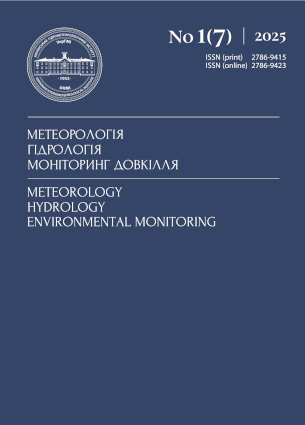AGROCLIMATIC ASSESSMENT OF LAND BIOLOGICAL PRODUCTIVITY OF THE DNIPROPETROVSK REGION IN THE CONDITIONS OF CLIMATE CHANGE
Оdessa I.I. Mechnikov National University
https://orcid.org/0000-0002-5179-6163
Andriy ZDEKX
Оdessa I.I. Mechnikov National University
https://orcid.org/
Abstract
References
1. Agroclimatic Handbook for the Dnipropetrovsk Region: (1986-2005) (2011) / edited by O.T. Prokhorenko, T.I. Adamenko. Dnipropetrovsk: “Polygraph – Media”.
2. Bi M., L. Wan, Z. Zhang, X. Zhang (2023). Spatio-Temporal Variation Characteristics of North Africa's Climate Potential Productivity, 12(9), 1710. https://doi.org/10.3390/land12091710
3. Brown R.A., N.J. Rosenberg (1999). Climate change impacts on the potential productivity of corn and winter wheat in their primary United States growing regions. Climatic Change, 41, 73–107.
4. Climate change and its impact on the Ukrainian economy: collective monograph (2015) / edited by CM. Stepanenka, A.M. Polovoy. Odessa: Publishing House “TES”.
5. Climatic risks of the functioning of Ukrainian economic sectors in the context of climate change: a collective monograph (2018) / edited by S.M. Stepanenko, A.M. Polyovoy. Odessa State Ecological University. Odesa: Publishing House “TES”.
6. Dan Cao, JIahua Zhang, Hao Yan, Lanan Xun. (2020). Regional Assessment of Climate Potential Productivity of Terrestrial Ecosystems and Its Responses to Climate Change Over China From 1980-2018. D. Cao et al.: Regional Assessment of CPP of Terrestrial Ecosystems and Its Responses to Climate Change, 8, 11138-11151.
7. Giorgi F., Colin Jones and Ghassem, R. Asrar (2009). Addressing climate information needs at the regional level: the CORDEX framework. WMO Bulletin., 58 (3), 175-183.
8. Evans J.P. (2011). CORDEX – An international climate downscaling initiative. 19th International Congress on Modelling and Simulation. Perth (Australia), 2705-2711.
9. Kyrnasivska N. V. (2022). Assessment of the bioclimatic potential of lands in complex terrain in the Lviv region. Modern research in world science. Proceedings of the 4th International scientific and practical conference. SPC “Sci-conf.com.ua”. (2022, Lviv, Ukraine). (рp. 379-385). URL: https://sci-conf.com.ua/iv-mizhnarodna-naukovo-praktichna-konferentsiya-modernresearch-in-world-science-10-12-07-2022-lviv-ukrayina-arhiv/.
10. Kyrnasivska N.V. (2016). Agroclimatic assessment and zoning of the bioclimatic potential of the territory of Odessa region. Scientific works of the Ukrainian Research Hydrometeorological Institute, 269, 158-166.
11. Kyrnasivska N.V., Shelestyuk O.G. (2023). Agroclimatic assessment of the bioclimatic potential of Vinnytsia region under climate change conditions. Ecological Sciences: Scientific and Practical Journal, 3(48), 71-77. DOI https://doi.org/10.32846/2306-9716/2023.eco.3-48.11
12. Latta G., H. Temesgen, T.M .Barrett (2009). Mapping and imputing potential productivity of Pacific Northwest forests using climate variables. Canadian Journal of Forest Research, 17 June,. https://doi.org/10.1139/X09-046
13. Lu Yanyu, Sun Wei, F. Yanqiu, T Weian (2022). Estimating the climatic potential productivity and the climatic capacity of food security based on the cropping structure in Anhui Province. Ecology and Environment, 31 (7), 1293-1305. DOI: 10.16258/j.cnki.1674-5906.2022.07.002
14. Meng, L.I., ZHU Yong, HUANG Wei (2010). Influence of Climate Change on Climate Potential Productivity in Yunnan[J]. Chinese Journal of Agrometeorology, 31(3), 442-446.
15. Methodological recommendations for organizing practical work on the topic 'Soil grading and qualitative assessment of lands' (2016). Compiled by: Ya. G. Tsytsyura. Vinnytsia: VNAU.
16. Myshchenko Z.A., Kirnasovskaya N.V. (2011). Agroclimatic resources of Ukraine and harvest: monograph Odessa: 'Ecology'.
17. Nazarenko I. I., Polchyna S. M. Nikorych V. A. (2004). Soil Science: Textbook. Chernivtsi: Knygy XXI, 400.
18. Qin Y., J. Liu, W. Shi, F. Tao, H. Yan. (2013). Spatial-temporal changes of cropland and climate potential productivity in northern China during 1990–2010. Food Security, 5, 499–512.
19. Volvach, O. V. (2011). Assessment of the bioclimatic potential of forest-steppe regions of Ukraine in relation to corn cultivation. Ukrainian Hydrometeorological Journal, 8, 162–169.

